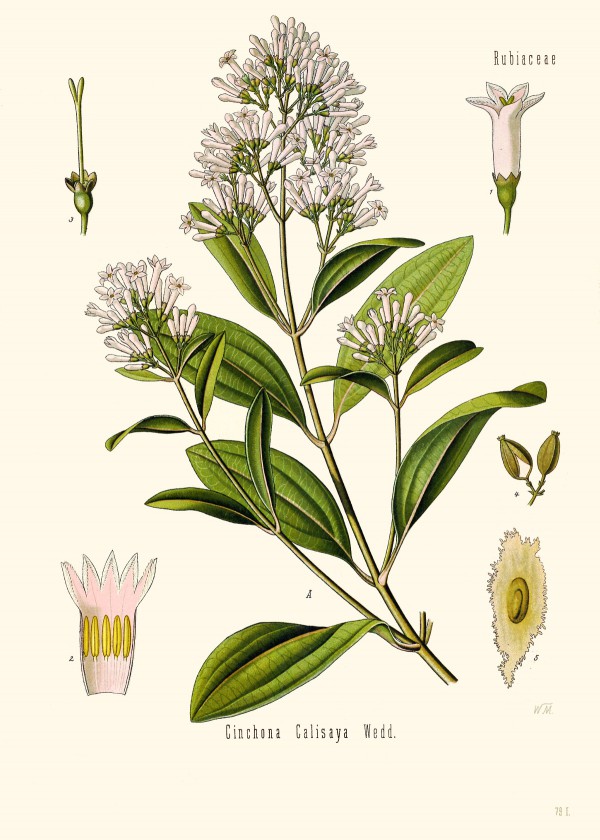Benutzer-Werkzeuge
Cinchona calisaya Wedd. - syn.Cinchona officinalis - Rubiaceae
China bark, yellow cinchona, Chinarindenbaum, (Gelbe) Chinarinde
Tree or large shrub, up to 15m high, native to Bolivia and Peru; leaves elliptic-oblong or lanceolate; flowers white, pale yellow, or pale pink. „Plants cultivated under the trade name Cinchona ledgeriana were considered to belong to C. calisaya by Andersson (Mem. New York. Bot. Gard. 80: 55-57. 1998). The description of the plants treated as C. ledgeriana by W. C. Chen (in FRPS 71(1): 224-225. 1999) agrees with Andersson’s classification of C. lancifolia Mutis and also generally matches the cultivated hybrid C. lucumifolia Pavon ex Lindley × C. pubescens (Andersson, loc. cit.: 60).“ http://www.efloras.org/florataxon.aspx?flora_id=2&taxon_id=242412650
„The Peruvian bark (with its active alkaloid quinine first isolated in 1820) has been used since the 16th century against fever and was particularly successful in Malaria fevers. Since the late 18th century quinine was a proven therapy against malaria. One can say that the quinine is pathognomonic for malaria; that
means if a fever is responsive to treatment with quinine, it is most likely a malarial fever.“
[Chinin als Malariatherapeutikum–prekär und unverzichtbar? Hulverscheidt, M.A., MPG Info, 2008, 83]
http://pubman.mpiwg-berlin.mpg.de/pubman/item/escidoc:643388:3/component/escidoc:644273/P356.PDF#page=85
„Studies on the chloroquine receptors on protease-treated normal mouse erythrocytes indicated that the receptor is created from a haemoglobin substrate and is an aggregated form of ferriprotoporphyrin IX. The affinity and specificity of ferriprotoporphyrin IX for chloroquine were also sufficient to account for chloroquine binding to erythrocytes infected with chloroquine-susceptible Plasmodium berghei. In equilibrium dialysis experiments, ferriprotoporphyrin IX had a dissociation constant for chloroquine of 3.5 X 10-9 M, and the following Ki values were obtained in experiments in which various compounds competed with chloroquine for binding to ferriprotoporphyrin IX : amodiaquine, 1.3 X 10-7 M; quinacrine, 1.2 X 10-7 M; quinine, 2.6 X 10-6 M; mefloquine, 1.6 X 10-5 M. When ferriprotoporphyrin IX was adsorbed to the erythrocyte surface, the dissociation constant for chloroquine increased to 2.3 X 10-7 M, indicating that the affinity of the interaction varies appreciably depending on the environment in which it occurs. Erythrocytes infected with chloroquine-susceptible P. berghei degrade haemoglobin and accumulate malarial pigment, which contains ferriprotoporphyrin IX, whereas erythrocytes infected with chloroquine-resistant P. berghei do not. In addition, when chloroquine-resistant lines of P. berghei revert to chloroquine susceptibility they also revert to the production of malarial pigment. It is concluded that ferriprotoporphyrin IX is the receptor responsible for chloroquine accumulation by erythrocytes infected with P. berghei.“
[Ferriprotoporphyrin IX fulfills the criteria for identification as the chloroquine receptor of malaria parasites., Chou, A.C., Chevli, R., Fitch, C.D., Biochemistry, Vol.19, 1980, 1543-1549]
„… quinine is efficacious in the prevention of nocturnal leg cramps. However, its benefit may not be as large as reported from the pooling of published studies alone. Given the side effect profile of quinine, nonpharmacologic therapy (e.g., regular passive stretching of the affected muscle) is the best first-line treatment. For persons who find this ineffective and whose quality of life is significantly affected, a trial of quinine is warranted.“
[Quinine for nocturnal leg cramps., Man-Son-Hing, M., Wells, G., Lau, A., Journal of general internal medicine, Vol.13(9), 1998, 600-606]
„23 randomised trials with a total of 1586 participants were included. Quinine was compared to placebo (20 trials), vitamin E (4 trials), a quinine-vitamin E combination (3 trials), and a quinine-theophylline combination (1 trial). The most commonly-used quinine dosage was 300 mg/day. Compared to placebo, quinine significantly reduced cramp number by 28%, cramp intensity by 10%, and cramp days by 20%. Cramp duration was not significantly affected. The other treatment comparisons were not significantly different to quinine. There were significantly more minor adverse events with quinine than placebo (risk difference, RD +3%), mainly gastrointestinal symptoms, but no difference in major adverse events (RD 0%).
Conclusion: There is moderate quality evidence that quinine significantly reduces cramp frequency, intensity and cramp days. With use up to 60 days, the incidence of serious adverse events is not significantly greater than placebo.“
[PO. 16 Is quinine useful in muscle cramps? A Cochrane meta-analysis., El-Tawil, S., Valli, H., Al Musa, T., Lunn, M.P.T., Weber, M., Journal of Neurology, Neurosurgery & Psychiatry, Vol.82(9), 2011, e4-e4]
Quinine prolongs the QT interval of the ECG and elevates the risk of cardiac arrhythmias. In addition, quinine inhibits the degradation of other drugs in the liver, leading to higher levels of them.
[Ärzteblatt 2013] http://www.aerzteblatt.de/nachrichten/57035/Risiken-und-Missbrauch-BfArM-fordert-Rezeptpflicht-fuer-Chinin

Cinchona calisaya Wedd., Köhler, F.E., Medizinal Pflanzen, vol.1 t.791 (1887) [W.Müller]
http://plantgenera.org/species.php?id_species=243232
